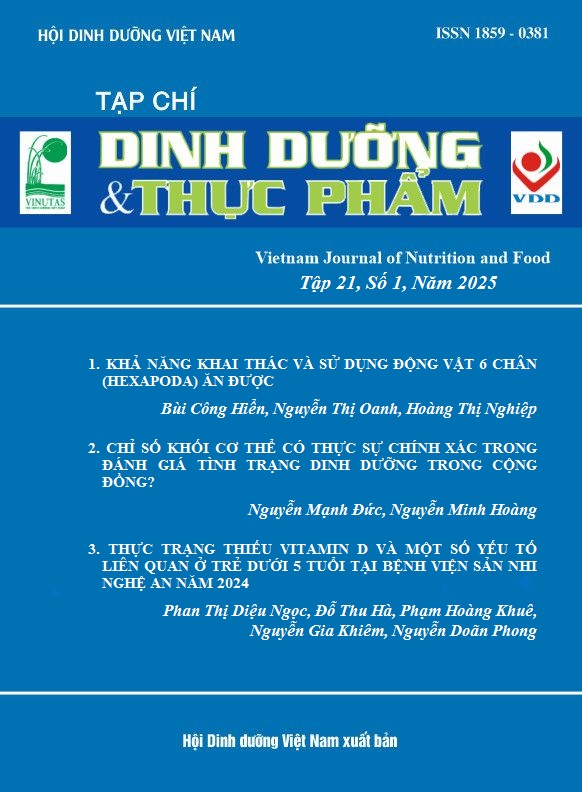THE ABILITY TO EXPLOIT AND USE EDIBLE HEXAPODAS
Main Article Content
Abstract
In 2019, the United Nations announced a rapid increase in global population, predicted to reach 9.74 billion people by 2050. Thus, food production may not be able to meet demand because arable land is increasingly scarce. This situation is further aggravated by climate change, water shortages and poverty.
Therefore, it requires a shift to new, cheap, environmentally friendly, climate-resilient and sustainable alternative food production systems. One of the promising options is eating insects - six-legged animals (according to the Food Security Information Network, 2019).
Although they are small animals, insects have a high reproductive capacity, so they create large biomass, have a fast growth rate, short harvest time, save space and have an available and cheap food source. Although not all edible insects have been analyzed for their biochemical composition to determine their nutritional value, in general, the analytical results obtained for some groups of insects show that the insect body contains a lot of protein, fat (lipid), minerals and vitamins. In particular, there are amino acids that humans need, but the body cannot synthesize itself.
Currently, people only encourage the breeding of some insect species such as Mealworms (Tenebrio molitor L.) or Crickets in commercial farms. The high potential of Crickets as food and animal feed has led to the development of livestock systems and the establishment of commercial Cricket farms in some countries in Asia, Europe, America, Australia and recently Africa.
Insects living in the wild may eat some plants containing toxins and these toxins accumulate in their bodies, so when people eat them, they will be poisoned.
Many authors have also noted that when raising insects, the composition of their food should be controlled, because if they eat food containing heavy metals or toxins, it will accumulate and when consumed, it will affect their health. In addition, some people have an allergic constitution such as rashes to the chitin of insects.
Keywords
insect food, edible insects.
Article Details
References
2. Omuse ER, Tonnang HEZ, Yusuf AA, Machekano H, Egonyu JP, Kimathi E, Mohamed SF, Kassie M, Subramanian S, Onditi J, Mwangi S, Ekesi S, Niassy S. The global atlas of edible insects: analysis of diversity and commonality contributing to food systems and sustainability. Sci Rep. 2024;14(1):5045. doi:10.1038/s41598-024-55603-7.
3. Premalatha M, Abbasi T, Abbasi T, Abbasi SA. Energy-efficient food production to reduce global warming and ecodegradation: The use of edible insects. Renew. Sustain. energy Rev. 2011;15:4357–4360. doi: 10.1016/j.rser.2011.07.115.
4. Jongema, Y. List of Edible Insects of the World (1 April 2017); Wageningen UR: Wageningen, The Netherlands, 2017; Available online: https://www.wur.nl/en/Research-Results/Chair-groups/Plant-Sciences/Laboratory-of-Entomology/Edible-insects/Worldwide-species-list.htm. Accessed on 3 September, 2024.
5. Joost Van Itterbeeck, Laurent Pelozuelo. How Many Edible Insect Species Are There? A Not So Simple Question. Diversity. 2022;14(2), 143; doi:10.3390/d14020143.
6. Tieu Nguyen Cong. Notes sur les insectes comestibles au Tonkin. Bull économique Ľindochine. 1928;3(198):735–744.
7. Hoàng Thị Hồng Nghiệp. Nghiên cứu côn trùng lâm nghiệp làm thực phẩm và đề xuất giải pháp bảo tồn chúng tại khu vực Tây Bắc, Việt Nam, Luận án Tiến sĩ lâm nghiệp. 2017.
8. van Huis A. Potential of insects as food and feed in assuring food security. Annu Rev Entomol. 2013;58:563-83. doi:10.1146/annurev-ento-120811-153704.
9. Phan Anh Tuấn. Sâu chit (Brihaspa atrostigmella Moore) sinh học và tác dụng chữa bệnh. Nxb Y học, Hà Nội. 2015.
10.Zagrobelny M, Dreon AL, Gomiero T, Marcazzan GL, Glaring MA, Møller BL. Toxic moths: Source of a truly safe delicacy. Journal of Ethnobiology. 2009;29(1):64-76.
11.Vijver M, Jager T, Posthuma L, Peijnenburg W. Metal uptake from soils and soil– sediment mixtures by larvae of Tenebrio molitor (L.) (Coleoptera). Ecotoxicol Environ Saf. 2003;54:277–289.
Similar Articles
- Dang Truong NGUYEN, Thuy Nga TRAN, Thi Nhung BUI, Danh Tuyen LE, EFFICACY OF A DAILY INTAKE OF A READY-TO- USE SUPPLEMENTARY FOOD (HEBI-MAM) AMONG VIETNAMESE PREGNANT WOMEN ON THEIR MATERNAL ANEMIA STATUS , Vietnam Journal of Nutrition & Food: Vol. 12 No. 5.2 (2016)
You may also start an advanced similarity search for this article.


